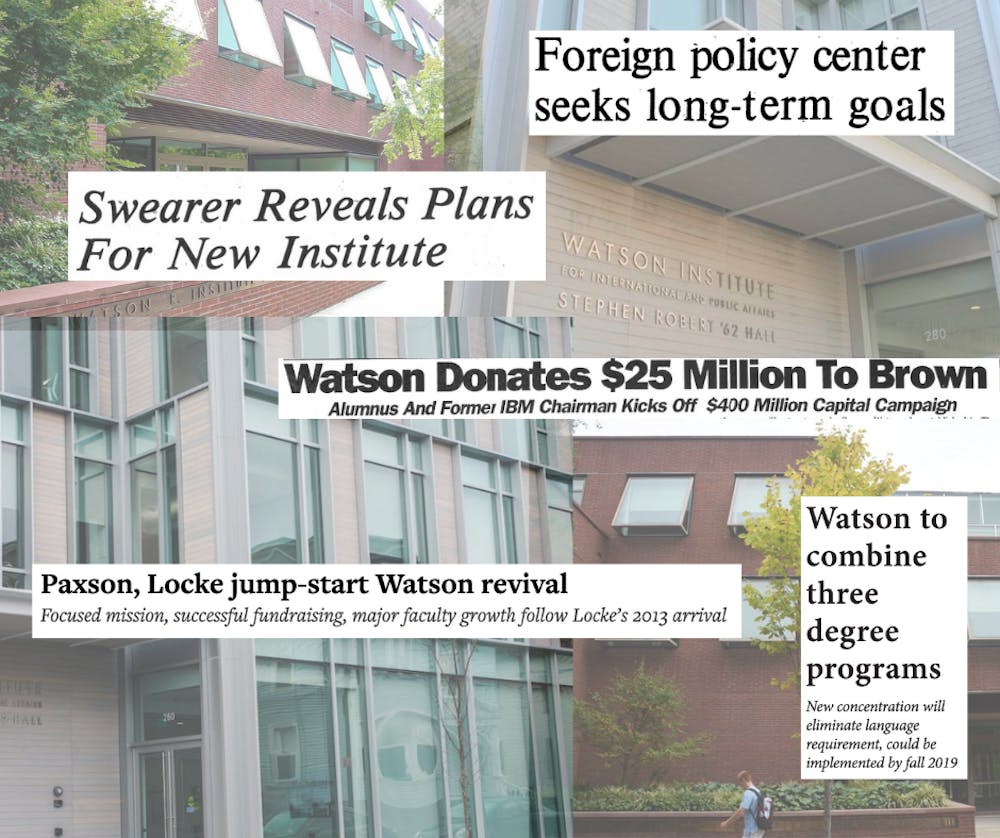On April 2, faculty approved a motion to create a School of International and Public Affairs, marking the next step in a continued push to develop Brown’s graduate program. The Corporation — the University’s highest governing body — is expected to vote on the motion this May, according to a proposed timeline shared by Provost Francis Doyle in March, though Corporation meeting agendas are not released to the public.
As deliberations continue, The Herald reviews the Watson Institute’s history from its inception to today.
‘80s: Not-so-humble beginnings
Watson traces its history back to 1979, when Brown launched the Council for International Studies “to explore solutions to the major global issues of the day, foremost of which was the possibility of a nuclear encounter between the United States and the Soviet Union.”
But in 1980, Thomas J. Watson Jr. ’37 had an idea. Then the U.S. ambassador to the Soviet Union, Watson invited then-University President Howard R. Swearer to visit Moscow to discuss the creation of a “‘think tank’ at Brown University, where scholars and practitioners could work together on nuclear strategy and U.S.-Soviet relations, and develop policy proposals for dealing with them,” according to the Watson Institute’s website.
This vision culminated in the Center for Foreign Policy Development, which was officially incorporated in 1982. Mark Garrison, who was a minister counselor in Moscow and deputy to Watson, served as the Center’s founding director. Watson chaired the board of advisors, and Swearer served as the board’s only other member. According to a 1981 Herald article, Watson was “funding the center’s activities from his own pocket.”
The Center largely focused on U.S.-Soviet affairs throughout its early years.
In 1985, Swearer announced during Convocation that Brown planned to create the Institute for International Studies, combining programs and centers under one umbrella. The Institute was approved by the Corporation in May of that year.
“The institute will help provide administrative and support services for international programs at Brown,” Swearer said, according to The Herald archives. “It will help shape faculty development in this area and provide some direction and funds for scholarly research and publication.”
The Institute was inaugurated in 1986, with ceremonies that saw former U.S. President Jimmy Carter and former Senator William Fulbright visit College Hill.
At the inauguration, Carter spoke to the pressing political issues of the time, including arms-control negotiations, the war in Nicaragua and sanctions against South Africa.
“The most important thing we can do as a nation is to impose rigid and punitive sanctions on the government of South Africa,” he said to a crowd of 5,000. “But in the absence of action in Washington, it is the responsibility of great universities like Brown … to uphold the moral standards of our nation,” he added, calling for divestment.
At the time, the Institute’s Associate Director Abbott Gleason told The Herald that the Institute was born out of undergraduate pressure, citing increased enrollment in foreign studies courses and the 1985 Third World protests.
Gleason emphasized that the University’s creation of the Institute did not represent a shift to become a primarily research-oriented institution, as “Brown ought not undertake programs that cannot be rooted centrally in the College,” Gleason told The Herald in 1986.
A gift and a new name
In 1991, two years before he passed away, Watson donated $25 million to the University, prompting the Brown Corporation to express its gratitude by voting for then-Brown President Vartan Gregorian to rename the institute in honor of Watson.
Along with his previous contributions, Watson’s gift made him the largest University donor at the time, according to a 1991 Herald article.
At this time, the Institute was directed by President Emeritus Howard R. Swearer and was associated with nearly a dozen groups and projects, according to the 1991 article. Swearer stated that Watson’s “support for academic programs has given Brown a deeply rooted dedication to higher education with an international scope.”
In 1997, the expanding institute began to plan for a move that would combine its programs, then spread across five locations, into one building. The ceremony for the groundbreaking of the building, located at 111 Thayer Street, took place in May 1999.
Watson’s expansion
In 2002, 111 Thayer Street opened its doors. It continues to house the Watson Institute to this day.
Between 2005 and 2012, the Institute had six directors.
In 2012, President Christina Paxson P’19 P’MD’20 came to Brown with a priority of “strengthening Watson and using Watson to strengthen allied departments.” Notably, Paxson previously served as the Dean of Princeton’s Woodrow Wilson School of International and Public Affairs.
The Institute expanded, increasing its program offerings and launching a fifth-year Master of Public Affairs program in 2014. This program prepares students to be public policy leaders, analysts and advocates in both private and public sectors, according to the program’s website. The program began its first recruitment cycle in 2017.
At the time, the curriculum included graduate classwork, work experience and a Global Policy Experience abroad, a 2017 Herald article previously reported. Today, the curriculum consists of graduate classes and a Policy-In-Action Project.
In 2015, the Watson Institute’s name was changed to the Watson Institute for International and Public Affairs. The institute received a $50 million gift which was used to fund the construction of a new building and expand the institute’s “faculty and initiatives aimed at deepening the University’s impact in addressing some of the world’s most vexing policy challenges.”
“A central theme of the University’s strategic plan and our comprehensive campaign is ‘creating peaceful, just and prosperous societies,’ and these resources help position Watson to lead in this area,” Paxson said when the donation was announced.
$25 million of the gift was used to fund the creation of a new 20,000-square-foot Watson Institute building — now Stephen Robert ’62 Hall, colloquially known by students as ‘New Watson’ — to accommodate additional faculty.
That same year, the University’s Operational Plan for Building Brown’s Excellence included hopes for the Institute to become a “top five school of its kind in the U.S.” In the 2018-2019 academic year, the University conducted a study to determine the feasibility of converting the Institute into a school.
Between 2012 and 2015, the Watson Institute raised $80 million and hired 13 new faculty members, The Herald previously reported.
As faculty and building space expanded, the Watson Institute shrunk its concentration offerings in 2019, combining development studies, international relations and public policy into one concentration called International and Public Affairs, the Herald previously reported.
The concentration would offer three tracks: Development, Security, and Policy and Governance.
While initial reactions to the change were mixed, IAPA became an incredibly popular concentration, with 121 students completing it in 2023. Students appreciated the concentration’s flexibility, and Watson director Edward Steinfeld cited closer advising relationships and more seminars as reasons for the change in a 2019 Herald article.
In 2023, a proposal to create a School of International and Public Affairs was drafted and received feedback from faculty at a March meeting. That fall, Doyle and Steinfeld co-chaired a task-force to address comments.
Today: The Watson Institute’s Next Steps
Pending Corporation approval, the school is predicted to open in July 2025 after a year-long planning period.
“We’re much bigger than we used to be,” Wendy Schiller, incoming interim director of the Watson Institute, said, explaining the reason behind the conversion to the school. “We have a masters in public affairs program, and we really want to build around that using the Brown faculty and raising its profile externally."
Schiller said she hopes that faculty and students will feel “welcome in the new school and really believe that it fits in with Brown’s core mission.” Doing so, she said, will lead to a school that informs “policy choices both in the United States and internationally.”
“It’s just a next step in the evolution of Brown being a more influential player in the policy sphere,” she said. Her hope for the future is that “the school will bring us greater public external recognition for the high-quality people that we have at Brown and for the high-quality work that they’re doing.”

Ryan Doherty is the managing editor of digital content and vice president of The Herald's 135th editorial board. He is a junior from Carmel, NY who is concentrating in chemistry and economics. He previously served as a university news and science & research editor, covering faculty and higher education.

Cate Latimer is a university news editor covering faculty, University Hall and higher education. She is from Portland, OR, and studies English and Urban Studies. In her free time, you can find her playing ultimate frisbee or rewatching episodes of Parks and Rec.





